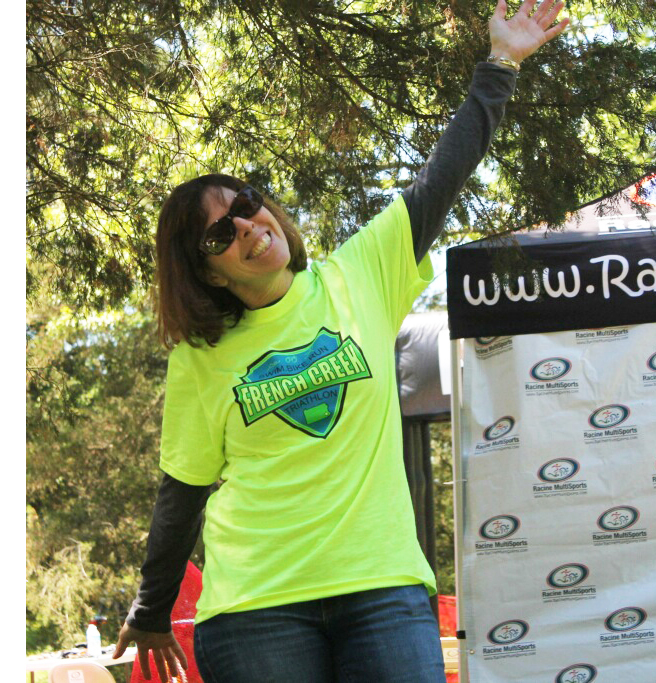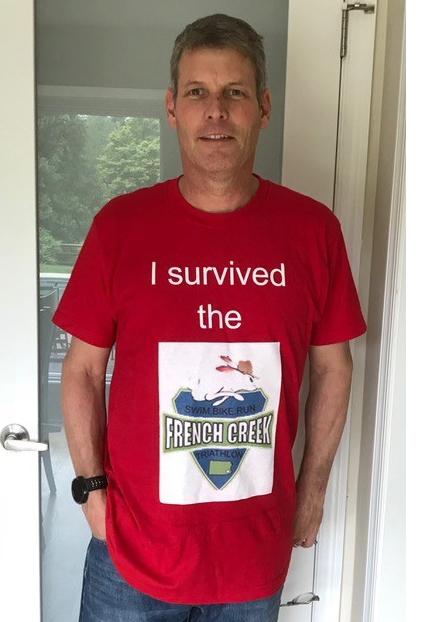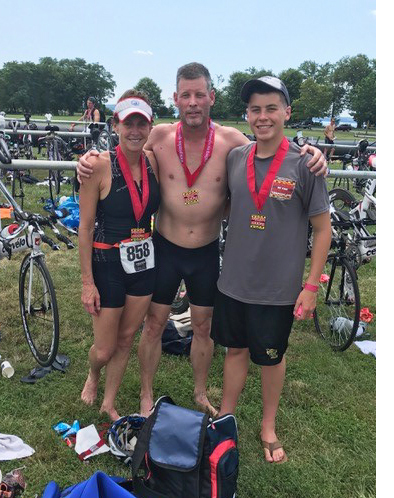Right Time, Right Place: PA Saves a Life
Effective CPR and AED Make the Difference for Airline Pilot
July 13, 2018
By Eileen Denne, CAE

If not for a PA who was in the right place at the right time during a Sunday, May 20 Olympic Triathlon in southeastern Pennsylvania, a 51-year-old airline pilot may not be alive today.
On a humid and overcast day at French Creek State Park in Berks and Chester counties, Loretta Connaughton, a PA since 1981, was volunteering at an aide station during the 2018 French Creek Triathlon in Elverson. Connaughton currently works out of Philadelphia for Industrial Medicine Associates conducting compensation and pension exams for Veterans and service members getting ready to exit the military.
[PAs Vote to Investigate Changing Their Professional Title]
There were around 150 competitors who started with a .9-mile swim, followed by 24 miles on a bike, concluding with a 6.2-mile run. The course is hilly and a good race for triathletes.
“My nephew John Kenny is the race director,” Connaughton said. “I was there strictly as a volunteer. My role was to tell everyone they had to go up the next big hill and then to tell the sprinters to go downhill. I was there to cheer them on, give them water, and say ‘Go!’”
At her station during the race, Connaughton heard yelling about 100 yards up the hill. She was volunteering with a young girl named Sarah. When they heard yelling, Sarah said she knew CPR and sprinted up the hill. When Loretta arrived, 51-year-old Edward (Ted) Brennan was unconscious on the ground. Bystanders had gotten a blanket and put a pillow under his head. Connaughton called for an ambulance on her walkie-talkie.
No heartbeat

“Sarah was trying to assess him,” Connaughton explained. “And I just basically pushed her out of the way. There was no heartbeat and I started compressions. I got his history from the walkie-talkie; they had Ted’s records and were able to give his name and age. I continued CPR until the Basic Life Service (BLS) team got there and they had an AED and were able to take over compressions. Six or seven people rotated. Ted was shocked four to five times with the AED before they got his heartbeat back.”
Once the EMTs got there, Connaughton walked away. “I knew they were certified. They knew what they were doing, and I was tired. Once we got a heartbeat, we were just rescue breathing for him.”
Connaughton went back to her volunteer station but was also looking for Ted’s wife Jennifer (Jenn) who was also competing in the race.
“This was our first race of 2018,” Jenn said. “We did our first half Ironman together last year. Ted was training to do a race called Escape from Alcatraz on June 2. At French Creek, I was having issues with my bike and I was way behind Ted. He was at mile 5 of the 6.2-mile run.”
As she was running up the hill, she heard Connaughton yelling her name. Jenn said, “Oh my God, where is my husband?” She asked if he was hit by a truck; when they said no, she asked if he had a heart attack. Yes, they said, and drove her to the ambulance, which took them to Reading hospital, about 40 minutes away.
Jenn works as a registered dietician in oncology at Lehigh Valley Health hospital. Ted is an airline pilot who has been flying for 29 years, first for the Navy and now for United Airlines. He also sells real estate. The Brennans have been married 27 years and have three children, ages 23, 21, and 18.
Marcie Basile, a neighbor and close friend of the Brennans, is a PA who works for Lehigh Valley Health Network in emergency medicine. Basile described Ted as an extremely healthy 51-year-old who is very active and not a weekend warrior. She talked about Ted’s situation after they arrived at Reading hospital.

‘Not all CPR is good CPR’
“Ted never regained consciousness. The emergency department quickly evaluated Ted, intubated him and sent him to the cath lab where he was found to have a complete left anterior descending artery occlusion (LAD). The LAD lesion was successfully stented and he was transferred to the ICU where he underwent a therapeutic hypothermia protocol.
During this protocol, the body temperature is reduced to a “mild hypothermic state” at 33 °C (91.4 °F) for 12 to 24 hours and then slowly re-warmed back to normal at 37 °C (98.6 °F). Lowering the body temperature helps reduce the risk of injury to the brain following a period of insufficient blood flow caused by cardiac arrest.
Basile and her husband, an emergency room physician at Lehigh Valley Health, went to the hospital to visit Ted while he was under sedation, thinking that they were saying their goodbyes.
“Under therapeutic hypothermia, once they warm a person up and wean him off sedation, then they wonder if the person will have brain damage,” Basile said.
During the move to the ICU, Jenn spoke to the cardiologist. “He seemed doom and gloom. I said, ‘you don’t understand — they got to Ted right away and did CPR’. This physician said, ‘Not all CPR is good CPR.’”
Hospital staff explained that after cooling his body and taking it back up to 98 degrees, ‘We expect to see nothing [from Ted] for 24 hours, more likely 48 hours; most likely on Thursday. And on Thursday, we will know a lot.’”
Completely cognitive and normal Ted
“On Tuesday he got to 98 degrees and he was waking up,” Jenn said. “They said whoever did CPR, they did perfect CPR. They realized Ted didn’t have the brain damage he could have had. He was good to go. It was so awesome. When Ted woke up, the doctor said, ‘I have to get the nurses in the cath lab; they have to see this.’
“We were able to leave the hospital Friday morning when they had said we would be there a minimum of 10 days. Even when we went back two weeks later to get another stent put in, one of the nurses said, ‘Wow, you’re the miracle guy!’”
From the time they got to the hospital to discharge was five days. He was, Basile says, “completely cognitive and normal Ted.”
She added, “It was a miracle. If it wasn’t for Loretta knowing what she was doing, this outcome wouldn’t have occurred. It was the start of all of the events that led to his full recovery.”

Not repeating family history
Asked how he was doing six weeks later, Ted described himself as pretty darn close to 100 percent. He is missing his memory from the day before the race to when he woke from the induced coma. He had not previously had health issues but does have a family history of heart attack.
“My experience is that I went from running to on the ground in cardiac arrest,” Ted continued. “Prognoses [for heart attacks] are very bad. If you search the term cardiac arrest, survival is less than six percent. I attribute almost 100 percent of where I am to Loretta. The rescue squad was there within a few minutes. I didn’t have a shot at it if Loretta wasn’t there.”
According to Jenn, Ted had been going to a cardiologist for 10 years due to his family history. His only other risk factor is hyperlipidemia for which he started taking Lipitor 10mg two months before the race. At 5’10” and 173 pounds, he is an otherwise healthy guy.
“Almost 30 years ago to the day, my dad passed away from a heart attack at my age — 51. That’s why I run, swim, and bike. I was trying to prevent what my family suffered through when I was a kid. I was an athlete in high school and college and for this to happen was shocking. At the end of the day, you can’t run from your genes.”
Alive to say thanks
Connaughton got a call on Tuesday when Ted woke up and was told he was breathing on his own and talking. She spoke on the phone with the Brennans about a month after the event.
“I had chills when I talked to them. Ted said he is 51 and said his father died at 51 of a heart attack and that I saved his family from the same experience. This guy could have been out training or if he had gone a different way, I never would have gotten to him. When I spoke to him I said, ‘I can’t wait to see what amazing things you do because the outcome could have been so different.’”
“Following CPR effectively and getting him where he could get a stent quickly; it just all worked. I told Sarah afterward, it doesn’t always happen like this. This is effective CPR. Five years ago, an AED wouldn’t have been there, and he wouldn’t have survived. Without the AED right there, there would have been a different outcome.”
Ted Brennan Paying it Forward
Ted said the biggest positive is that he is alive and well. An equally positive outcome from his experience is that the Brennans created a GoFundMe account, Ted Brennan Paying it Forward, to say thanks. After his heart attack, Ted said people wanted to help and Jenn said, ‘I don’t want 13 lasagnas. Why don’t we give people a way to give back.’
Their GoFundMe account has exceeded its goal of collecting $15,000 to purchase AEDs. As president of a summer swim league, Ted said all 12 teams will get AEDs and they hope to continue to put AEDs in places that don’t have them, such as local Boy and Girl Scout troops, plus the Roadrunners clubs. See their GoFundMe page here.
Connaughton also shared her thanks with the team that helped the Brennans. “On Monday [after the race] I sent a note to the ambulance company director commending his team on how well they did and how professional they were. They were young guys. For one guy, I could tell it was his first.”
“I am so grateful I was able to be there and I knew what to do. It happened so quickly it went by in a blur; I just did what I do.”
More Resources:
Association of PAs in Cardiology
Cardiology PAs Get to the Heart of the Matter
Eileen Denne is director of Corporate Communications at AAPA. Contact her at [email protected].
Thank you for reading AAPA’s News Central
You have 2 articles left this month. Create a free account to read more stories, or become a member for more access to exclusive benefits! Already have an account? Log in.



